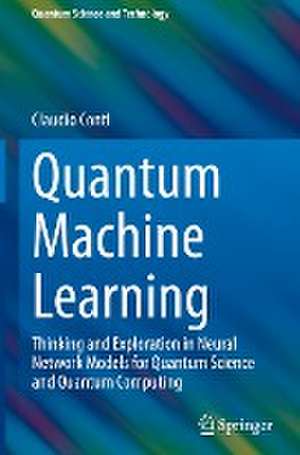Quantum Machine Learning: Thinking and Exploration in Neural Network Models for Quantum Science and Quantum Computing: Quantum Science and Technology
Autor Claudio Contien Limba Engleză Hardback – 3 ian 2024
Din seria Quantum Science and Technology
- 15%
 Preț: 530.42 lei
Preț: 530.42 lei - 17%
 Preț: 362.72 lei
Preț: 362.72 lei -
 Preț: 425.20 lei
Preț: 425.20 lei - 18%
 Preț: 783.20 lei
Preț: 783.20 lei - 15%
 Preț: 643.34 lei
Preț: 643.34 lei - 18%
 Preț: 1226.24 lei
Preț: 1226.24 lei - 15%
 Preț: 644.95 lei
Preț: 644.95 lei - 18%
 Preț: 950.21 lei
Preț: 950.21 lei - 18%
 Preț: 908.52 lei
Preț: 908.52 lei - 18%
 Preț: 729.53 lei
Preț: 729.53 lei - 20%
 Preț: 928.77 lei
Preț: 928.77 lei - 18%
 Preț: 1114.34 lei
Preț: 1114.34 lei - 18%
 Preț: 1119.32 lei
Preț: 1119.32 lei -
 Preț: 451.48 lei
Preț: 451.48 lei - 18%
 Preț: 890.06 lei
Preț: 890.06 lei - 18%
 Preț: 782.57 lei
Preț: 782.57 lei - 18%
 Preț: 939.94 lei
Preț: 939.94 lei - 18%
 Preț: 892.90 lei
Preț: 892.90 lei - 18%
 Preț: 947.18 lei
Preț: 947.18 lei - 15%
 Preț: 653.33 lei
Preț: 653.33 lei
Preț: 792.34 lei
Preț vechi: 966.26 lei
-18% Nou
Puncte Express: 1189
Preț estimativ în valută:
151.62€ • 158.62$ • 125.95£
151.62€ • 158.62$ • 125.95£
Carte tipărită la comandă
Livrare economică 02-16 aprilie
Preluare comenzi: 021 569.72.76
Specificații
ISBN-13: 9783031442254
ISBN-10: 3031442253
Pagini: 378
Ilustrații: XXIII, 378 p. 109 illus., 66 illus. in color.
Dimensiuni: 155 x 235 mm
Greutate: 0.74 kg
Ediția:1st ed. 2024
Editura: Springer International Publishing
Colecția Springer
Seria Quantum Science and Technology
Locul publicării:Cham, Switzerland
ISBN-10: 3031442253
Pagini: 378
Ilustrații: XXIII, 378 p. 109 illus., 66 illus. in color.
Dimensiuni: 155 x 235 mm
Greutate: 0.74 kg
Ediția:1st ed. 2024
Editura: Springer International Publishing
Colecția Springer
Seria Quantum Science and Technology
Locul publicării:Cham, Switzerland
Cuprins
Chapter 1: Quantum mechanics and data-driven physics.- Chapter 2: Kernelizing quantum mechanics.- Chapter 3: Qubit maps.- Chapter 4: One qubit transverse-field Ising model and variational quantum algorithms.- Chapter 5: Two-qubit transverse-field Ising model and entanglement.- Chapter 6: Variational Algorithms, Quantum Approximation Optimization and Neural Network Quantum States with two-qubits.- Chapter 7: Phase space representation.- Chapter 8: States as a neural networks and gates as pullbacks.- Chapter 9: Quantum reservoir computing.- Chapter 10: Squeezing, beam splitters, and detection.- Chapter 11: Uncertainties and entanglement.- Chapter 12: Gaussian boson sampling.- Chapter 13: Variational circuits for quantum solitons.
Notă biografică
Claudio Conti is an associate professor at the Department of Physics of the University Sapienza of Rome. He authored over 250 articles in many fields, such as quantum physics, photonics, nonlinear science, biophysics, and complexity. His activity includes experiments and theory, such as the first observation of replica symmetry breaking mentioned in the scientific background of the Nobel prize in physics in 2021, the investigation of neuromorphic computing by quantum fluids, and the optical acceleration of natural language processing. Claudio Conti coordinates an experimental and theoretical group in Rome exploring the frontiers of artificial intelligence and physics.
Textul de pe ultima copertă
This book presents a new way of thinking about quantum mechanics and machine learning by merging the two. Quantum mechanics and machine learning may seem theoretically disparate, but their link becomes clear through the density matrix operator which can be readily approximated by neural network models, permitting a formulation of quantum physics in which physical observables can be computed via neural networks. As well as demonstrating the natural affinity of quantum physics and machine learning, this viewpoint opens rich possibilities in terms of computation, efficient hardware, and scalability. One can also obtain trainable models to optimize applications and fine-tune theories, such as approximation of the ground state in many body systems, and boosting quantum circuits’ performance. The book begins with the introduction of programming tools and basic concepts of machine learning, with necessary background material from quantum mechanics and quantum information also provided. This enables the basic building blocks, neural network models for vacuum states, to be introduced. The highlights that follow include: non-classical state representations, with squeezers and beam splitters used to implement the primary layers for quantum computing; boson sampling with neural network models; an overview of available quantum computing platforms, their models, and their programming; and neural network models as a variational ansatz for many-body Hamiltonian ground states with applications to Ising machines and solitons. The book emphasizes coding, with many open source examples in Python and TensorFlow, while MATLAB and Mathematica routines clarify and validate proofs. This book is essential reading for graduate students and researchers who want to develop both the requisite physics and coding knowledge to understand the rich interplay of quantum mechanics and machine learning.
Caracteristici
Presents a new way of thinking about quantum physics by introducing machine learning from the beginning Places coding at the forefront, with plenty of open-source examples Shows how neural networks can fine-tune quantum models and optimize device applications
